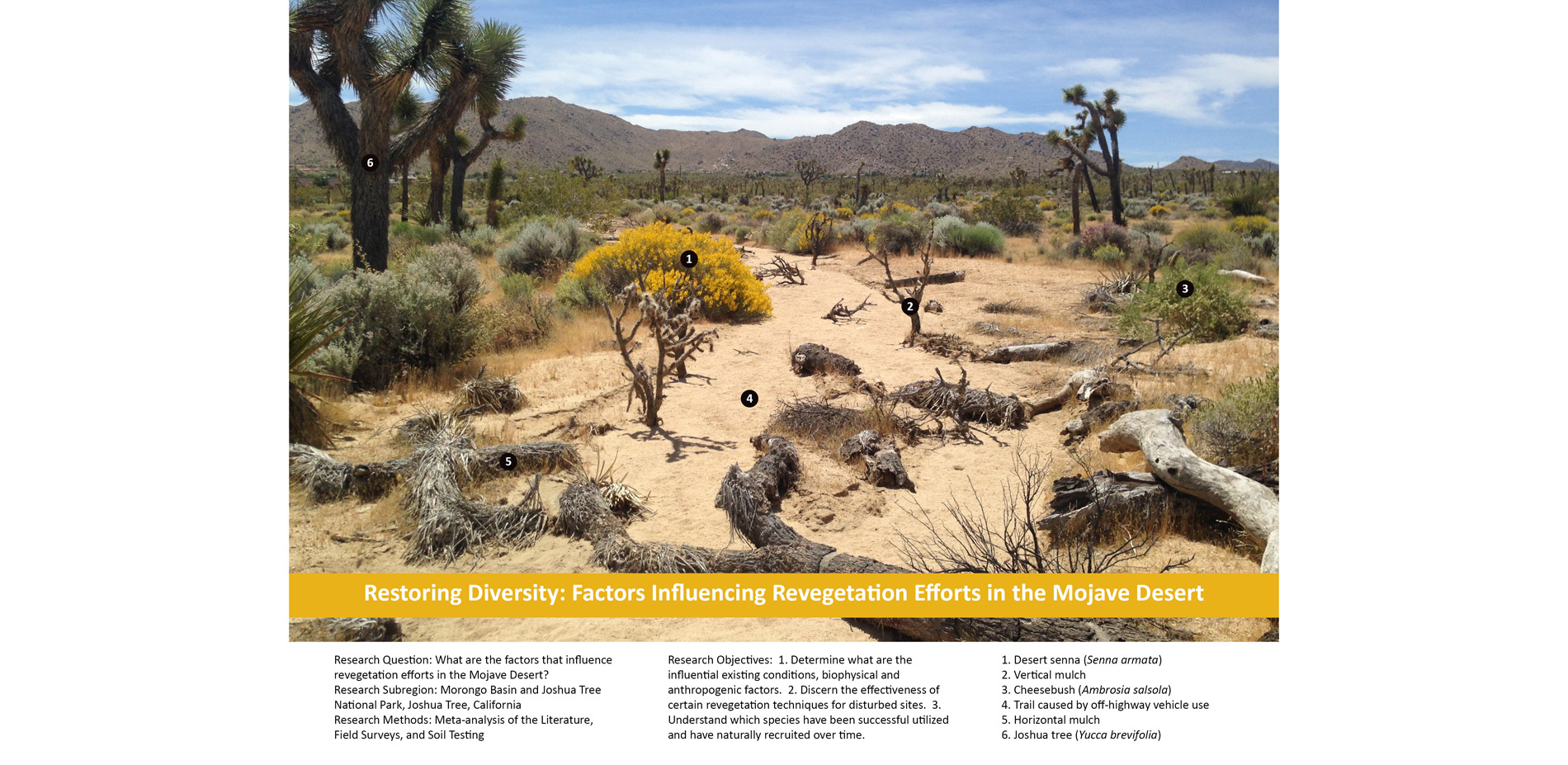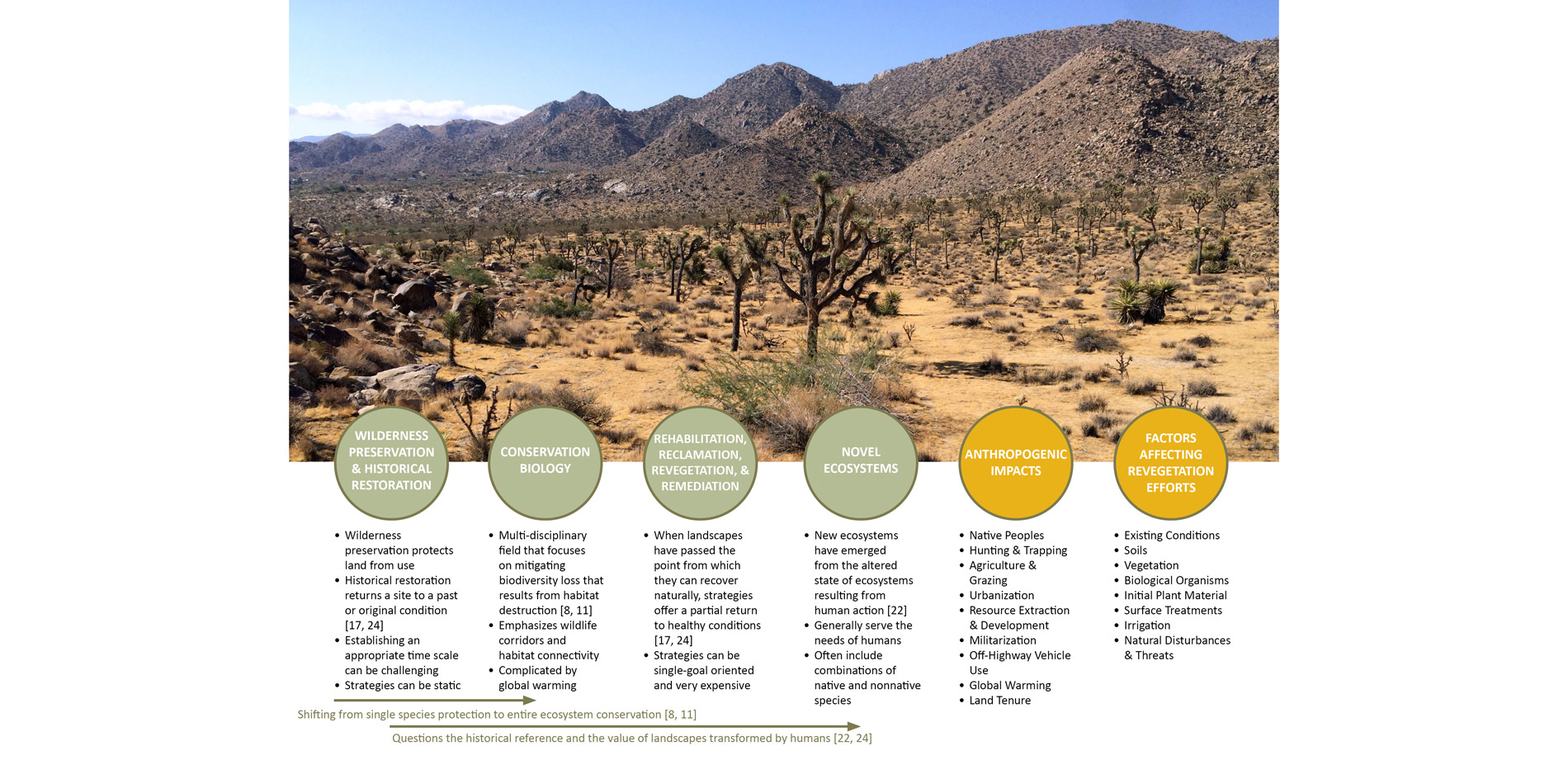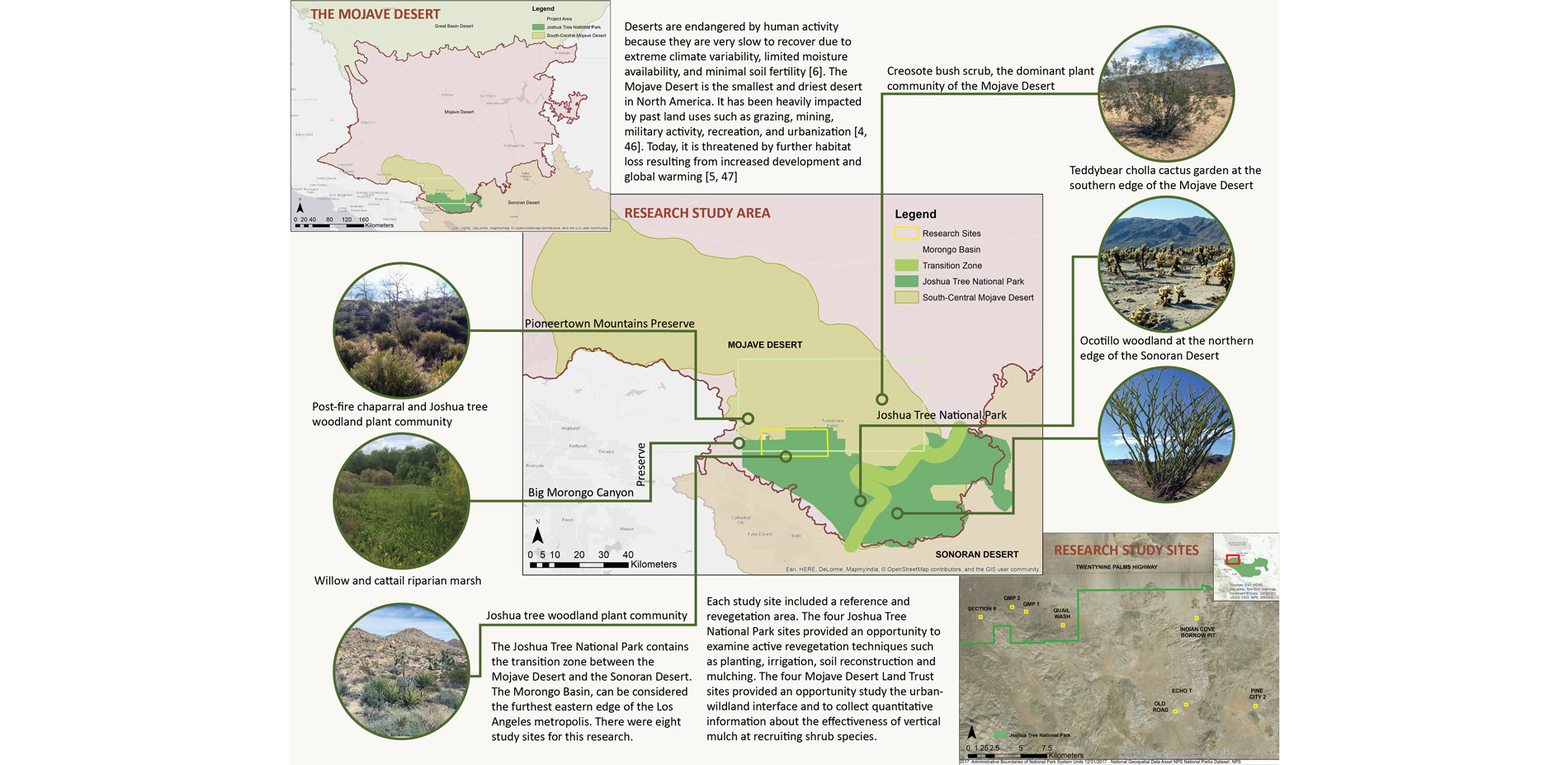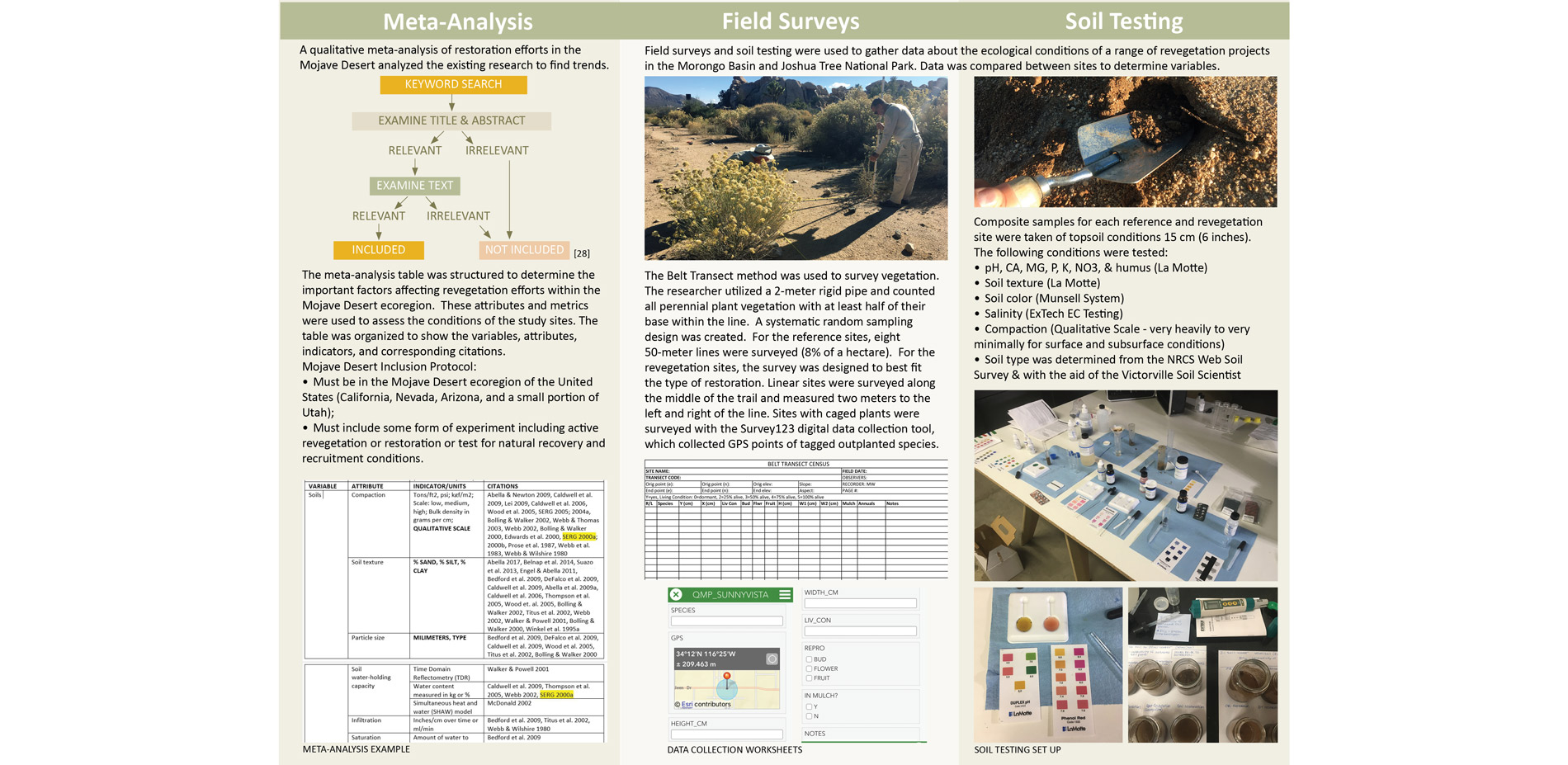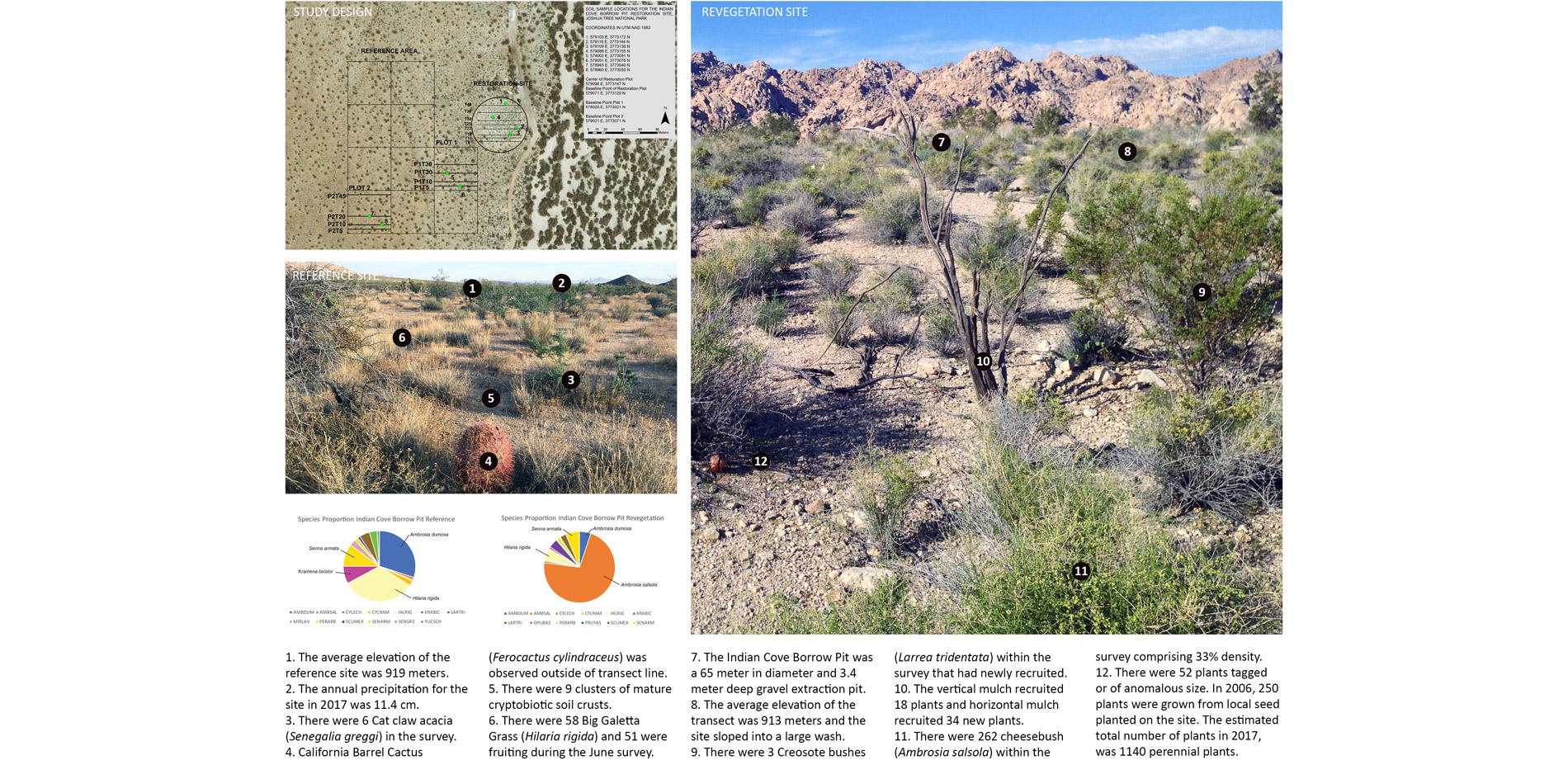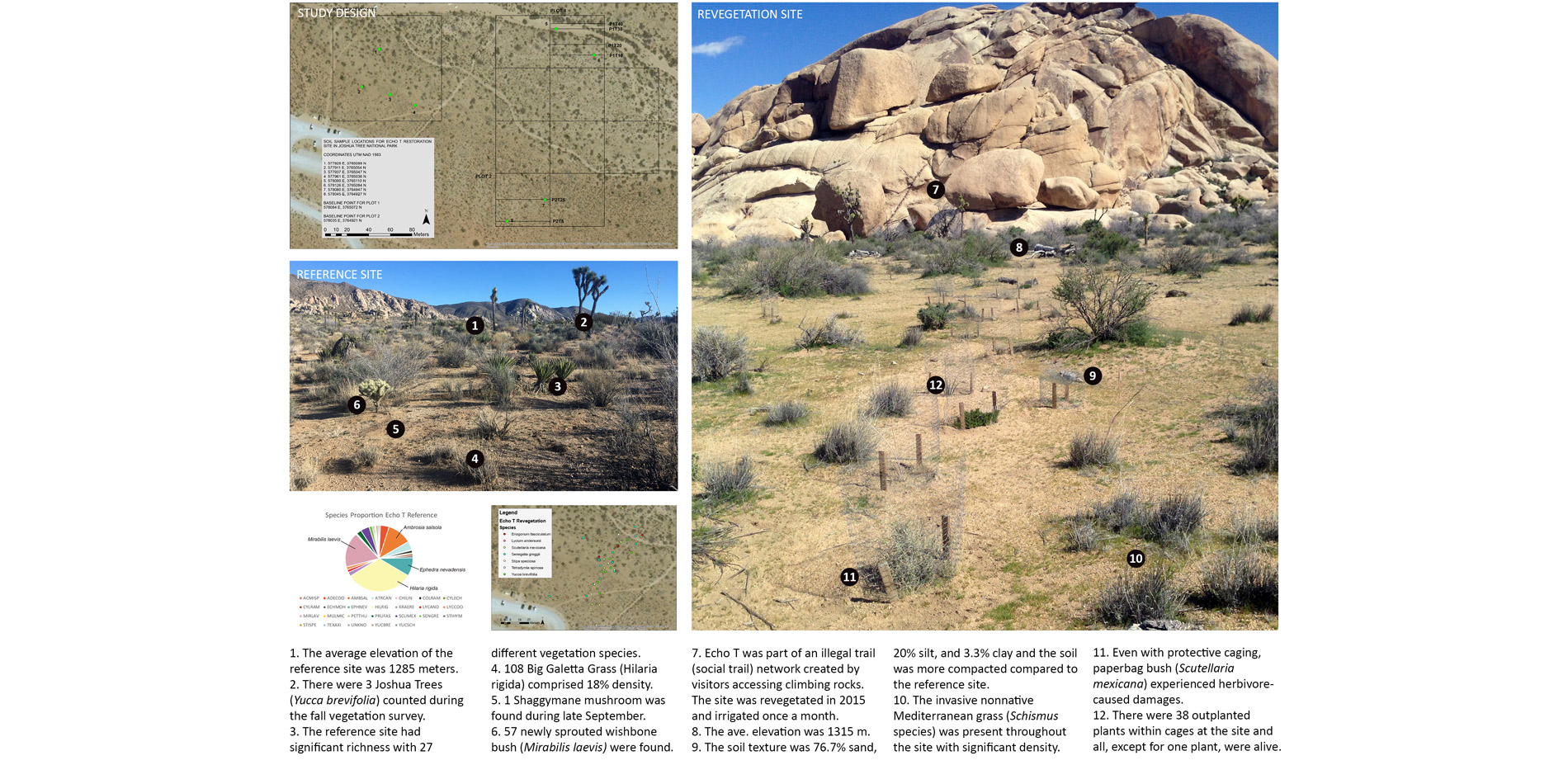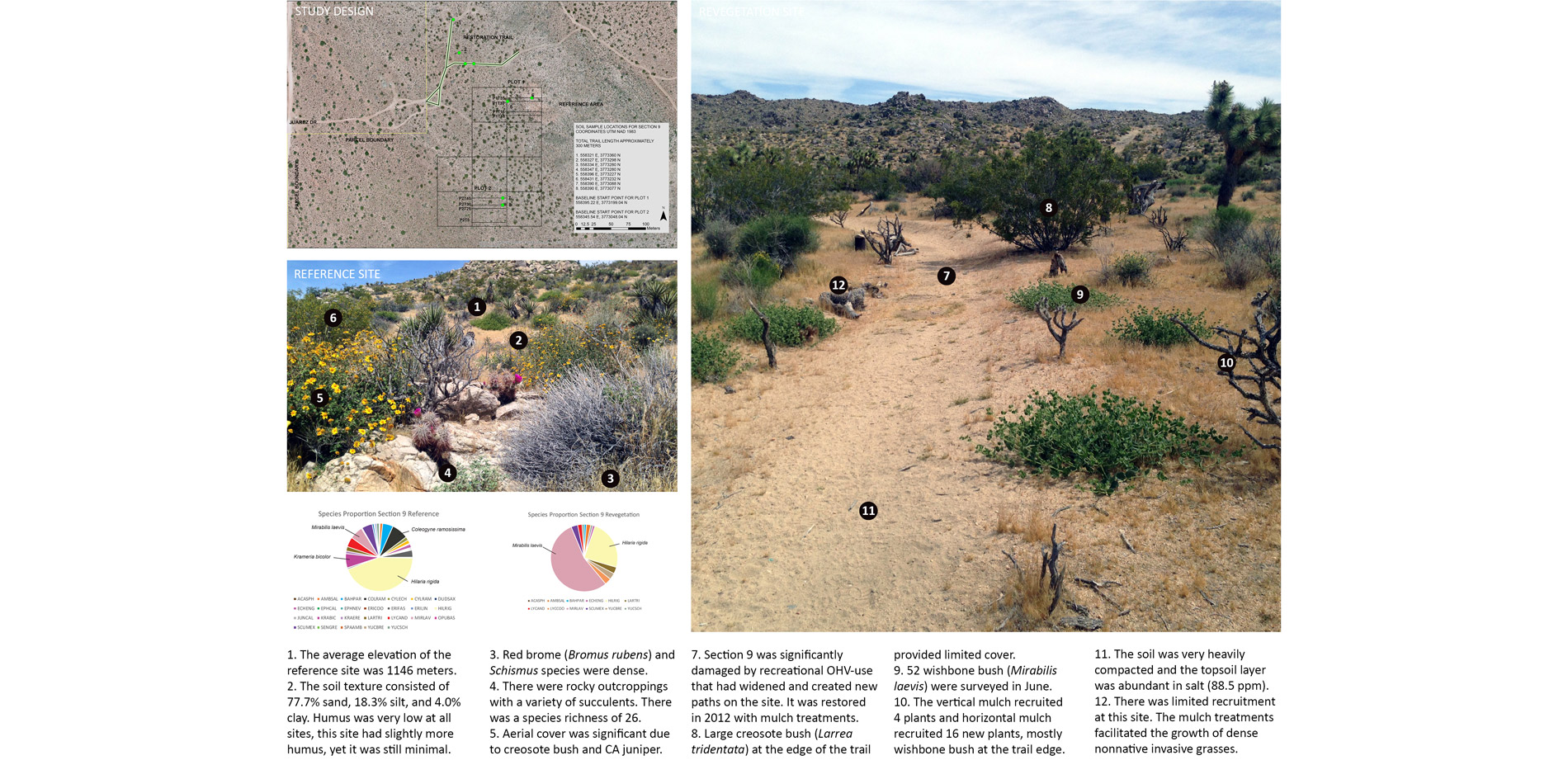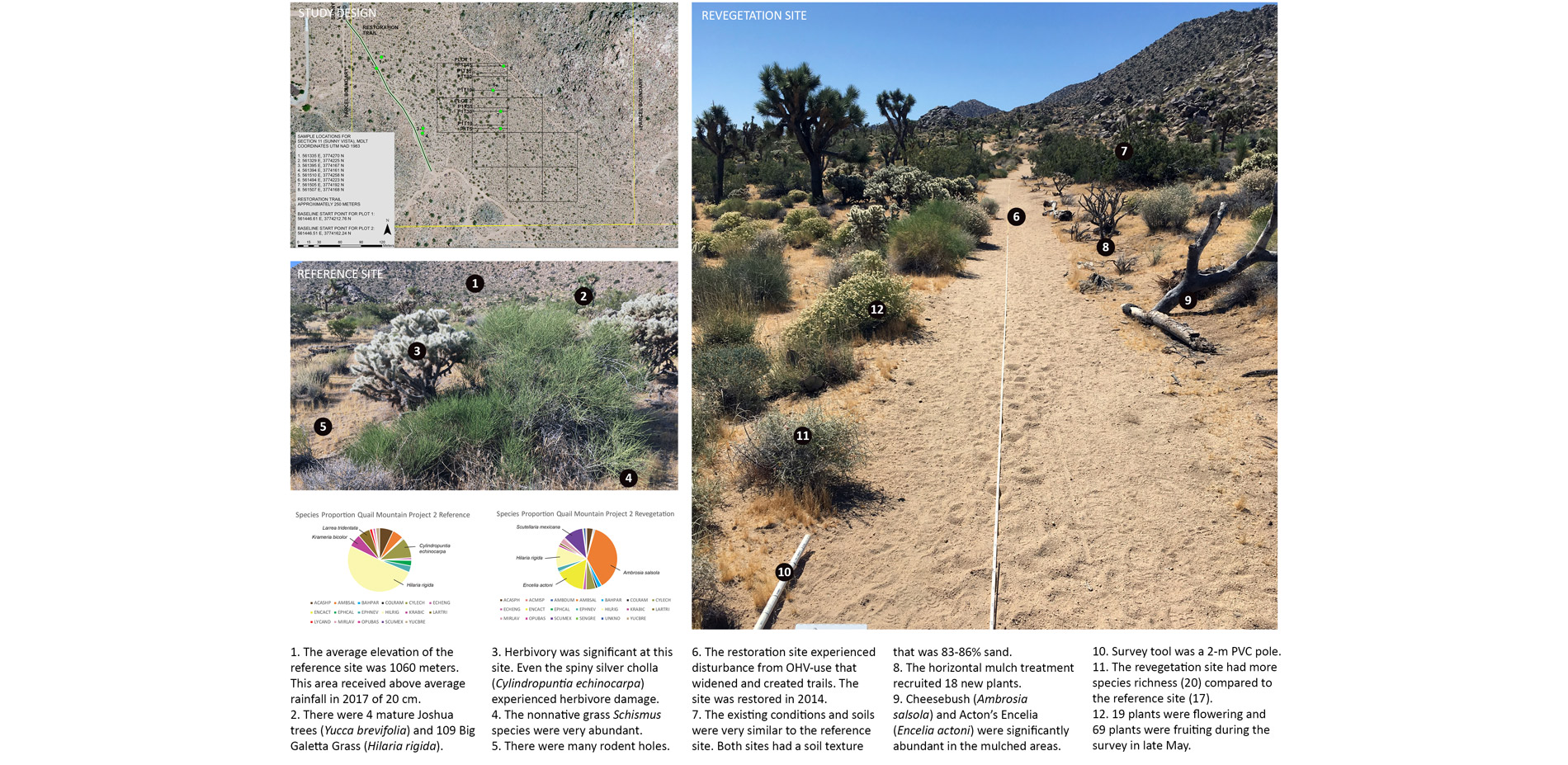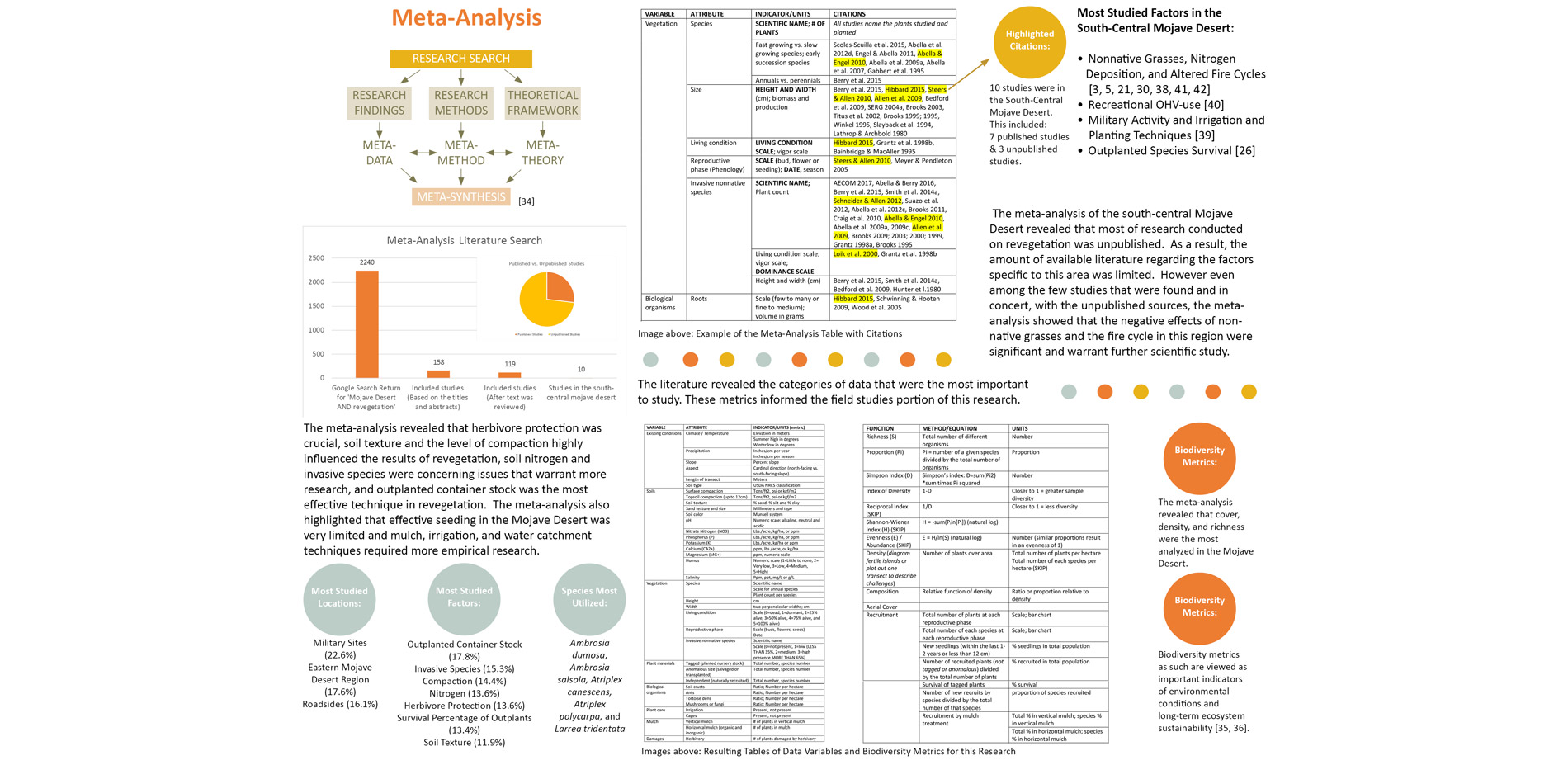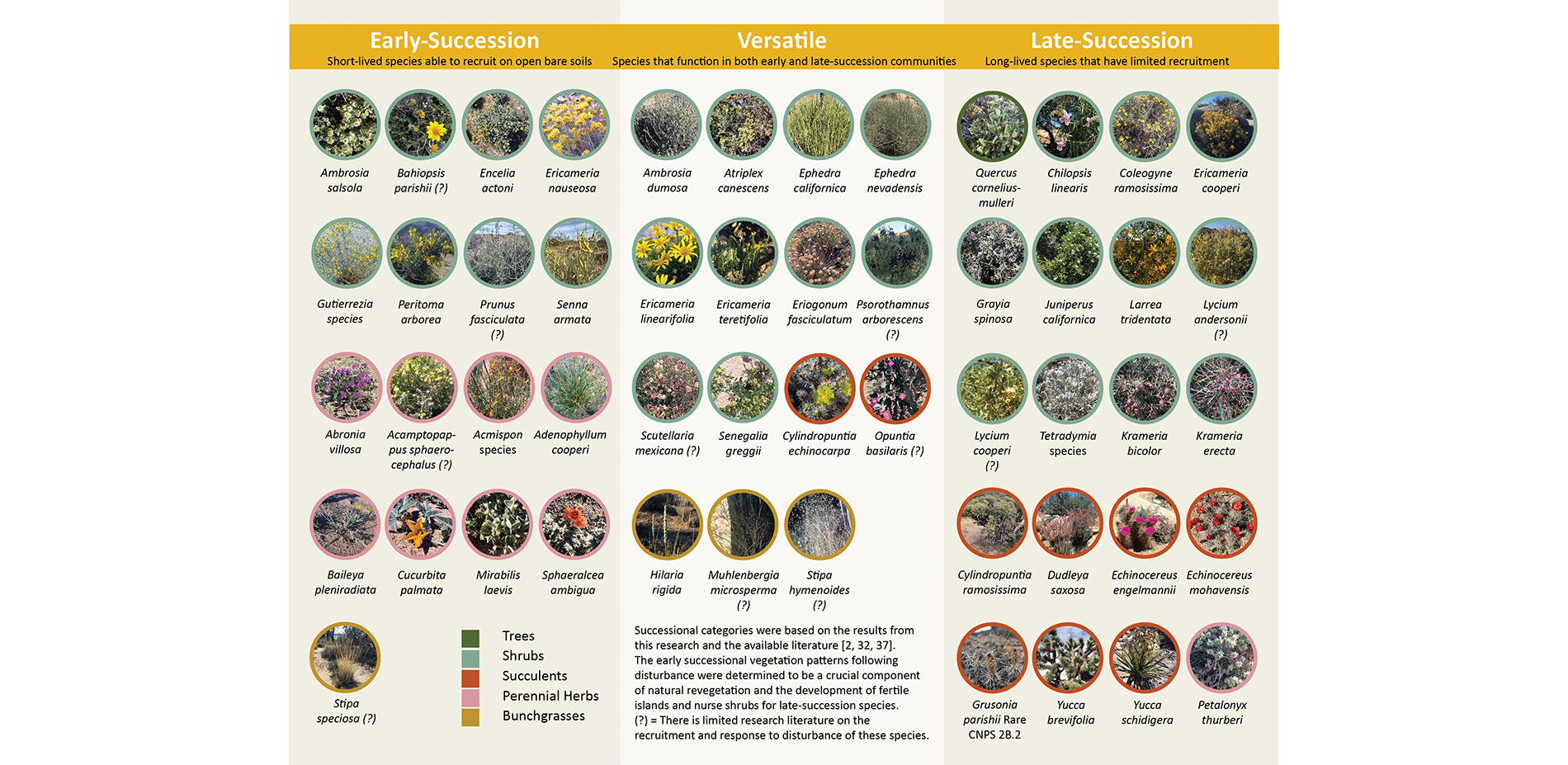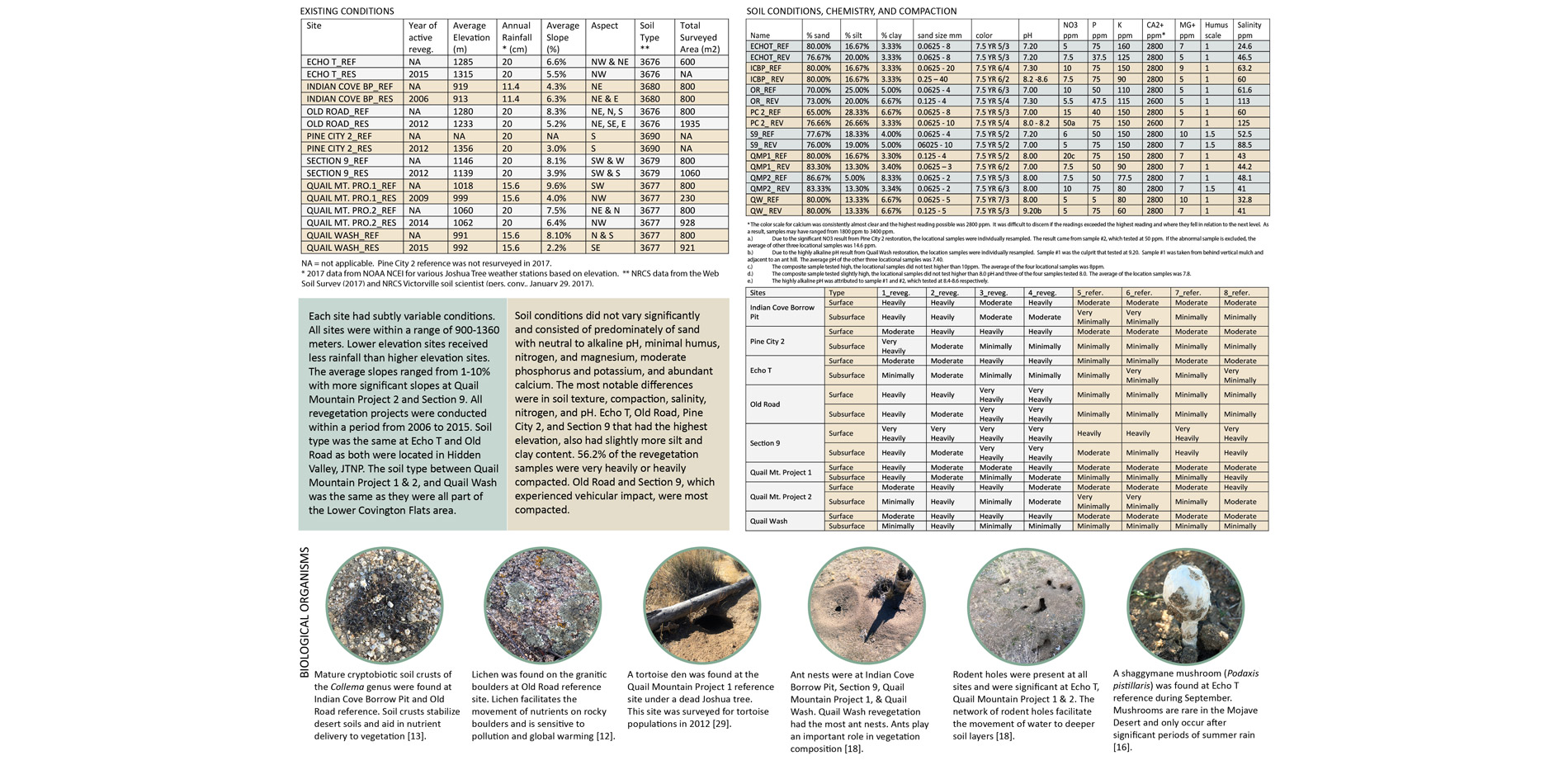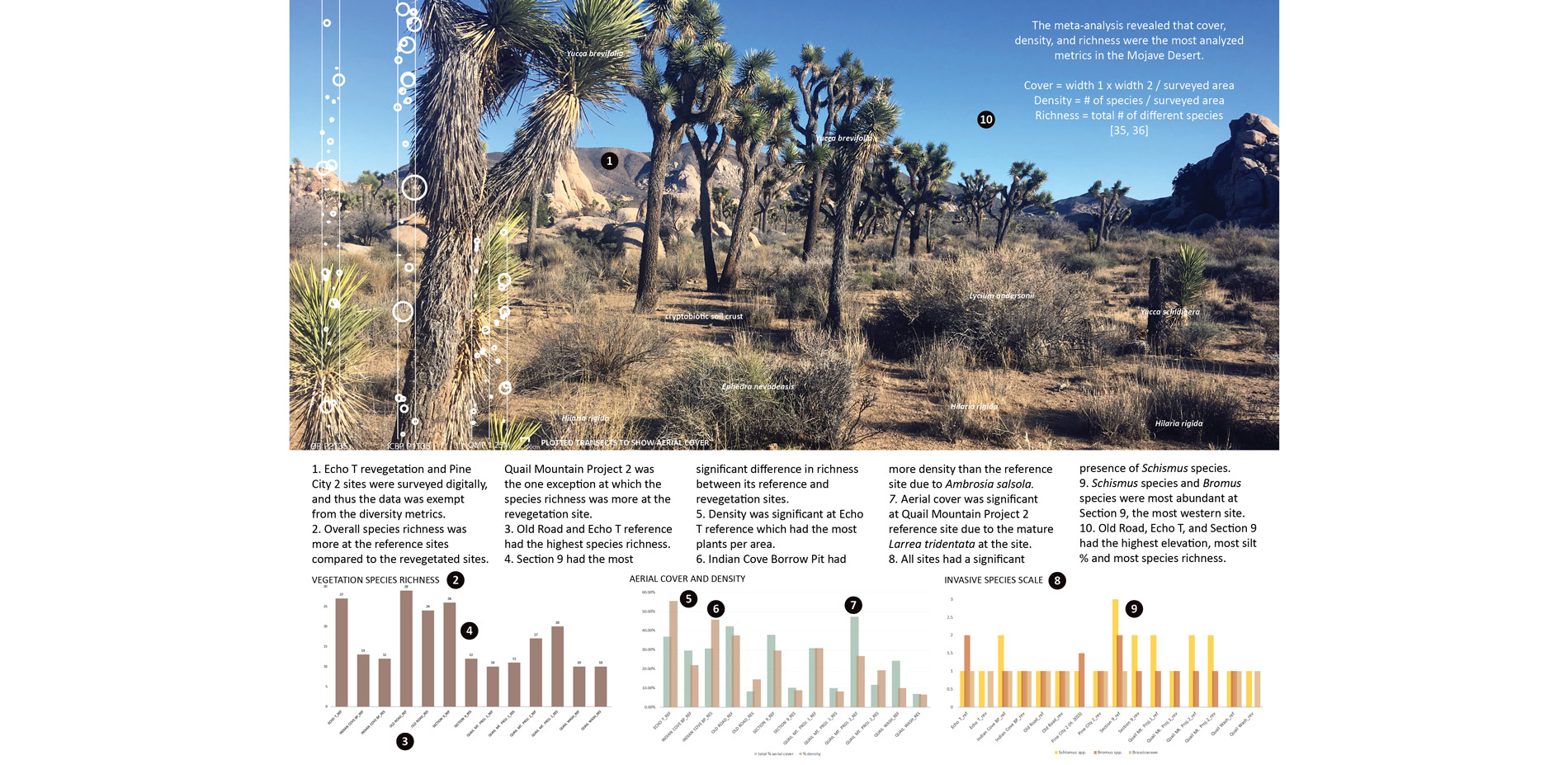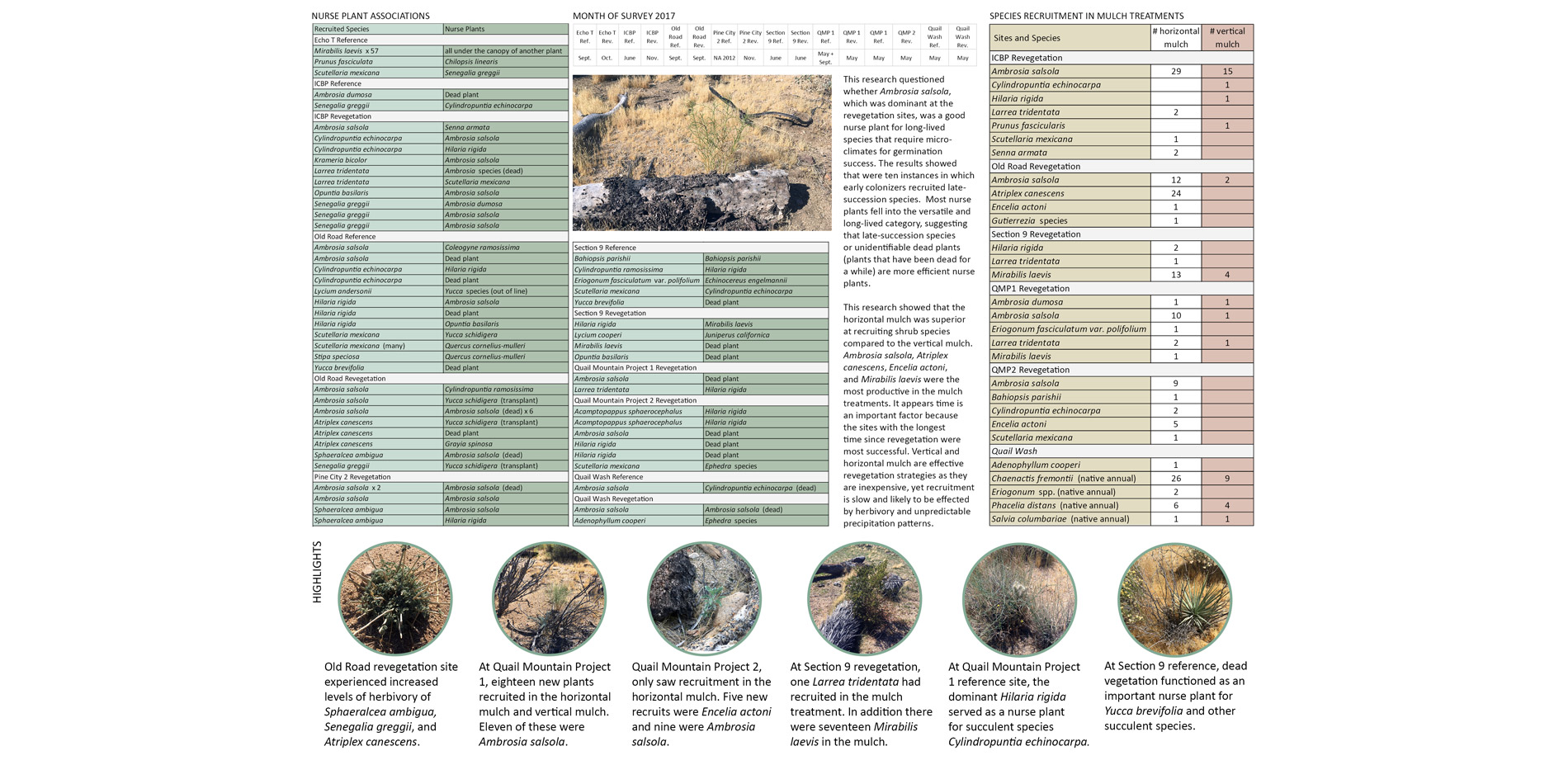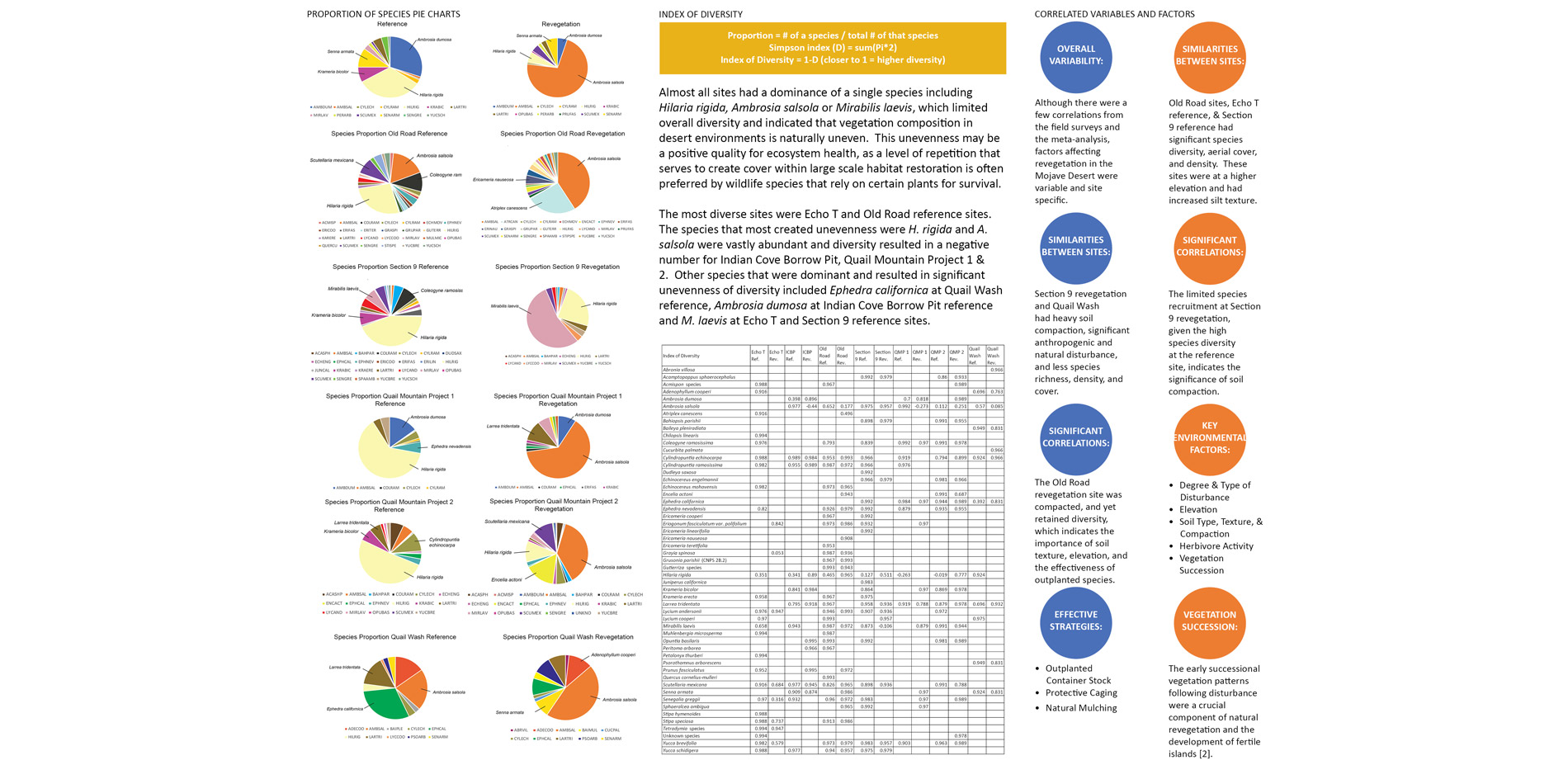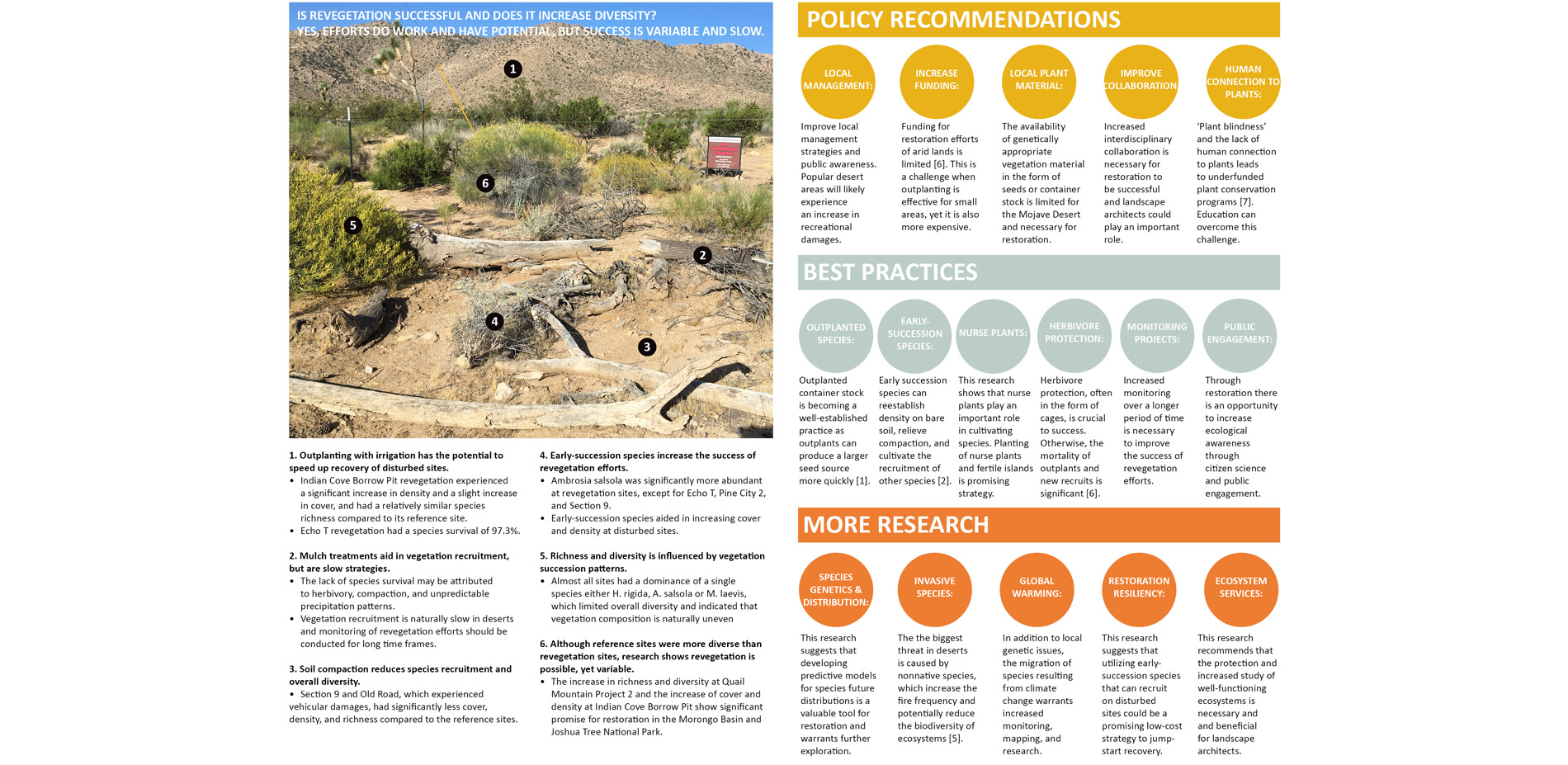Restoring Diversity: Factors Influencing Revegetation Efforts in the Mojave Desert
AWARD OF EXCELLENCE
Research
Joshua Tree National Park and Mojave Desert Land Trust, USA | Marinna Wagner, Student ASLA | Faculty Advisors: Susan J. Mulley, ASLA
Cal Poly Pomona
Probably the most rigorous research project in this category. . . It had a good balance of secondary resources and primary research. . .
- 2018 Awards Jury
PROJECT CREDITS
- Neil Frakes, Vegetation Branch Chief, Joshua Tree National Park
- Joshua Tree National Park, Archaeology and Vegetation Departments
- Mojave Desert Land Trust, Executive and Stewardship Teams
- Tom Kayne, Technical Advisor
- Tom Rottman, Technical Advisor
- William Wagner, Technical Advisor
- Madena Asbell, Director of Plant Conservation Programs, Mojave Desert Land Trust
- Scott Kleinrock, MLA, Chino Basin Water District - Thesis Defense Committee
- Gerald Taylor, MLA, Department of Landscape Architecture Cal Poly Pomona - Thesis Defense Committee
- James Ochmanek, Consultant
- Peter Fahnestock, NRCS California
- Charlie Rossow, Morongo Basin Historical Society
- Julianne Wagner, Consultant
Citations
- Abella, S. R. (2017). Persistent Establishment of Outplanted Seedlings in the Mojave Desert. Ecological Restoration, 35(1), 16-19.
- Abella, S. R. (2010). Disturbance and Plant Succession in the Mojave and Sonoran Deserts of the American Southwest. International Journal of Environmental Research and Public Health, 7, 1248-1284. doi:10.3390/ijerph7041248
- Abella, S. R., & Engel, C. (2010). Evaluating efficacy of restoration techniques, Keys View Road reconstruction, Joshua Tree National Park. Mojave Applied Ecology Notes, 3(2), 3-4.
- Allen, M., Barrows, C., Bell, M., Jenerette, G., Johnson, R., & Allen, E. (2014, May). Threats to California's Desert Ecosystems. Fremontia, 42(2), pp. 3-7. Retrieved from https://www.cnps.org/publications/fremontia
- Allen, E., Rao, L., Steers, R., Bytnerowicz, A., & Fenn, M. (2009). Impacts of Atmospheric Nitrogen Deposition on Vegetation and Soils at Joshua Tree National Park. In R. Webb, L. Fenstermaker, J. Heaton, D. Hughson, E. McDonald, & D. Miller, The Mojave Desert: Ecosystem Processes and Sustainability (pp. 78-100). Reno and Las Vegas: University of Nevada Press.
- Bainbridge, D. A. (2007). A Guide for Desert and Dryland Restoration: A New Hope for Arid Lands. Washington D. C.: Island Press.
- Balding, M., & Williams, K. (2016). Plant blindness and the implications for plant conservation. Conservation Biology, 00(0), 1-8.
- Barnosky, A., Hadly, E., Gonzalez, P., Head, J., Polly , P., Lawing, A., . . . Zhang, Z. (2017). Merging Paleobiology with Conservation Biology to Guide the Future of Terrestrial Ecosystems. Science, 355(594), 1-10.
- Barrows, C. W., Hoines, J., Fleming, K. D., Vamstad, M. S., Murphy-Mariscal, M., Lalumiere, K., & Harding, M. (2014). Designing a sustainable monitoring framework for assessing impacts of climate change at Joshua Tree National Park, USA. Biodiversity Conservation, 233, 3263-3285.
- Barrows, C. W., & Murphy-Mariscal, M. (2012). Modeling impacts of climate change on Joshua trees at their southern boundary: How scale impacts predictions. Biological Conservation, 152, 29-36.
- Barrows, C., Swartz, M., Hodges, W., Allen, M., Rotenberry, J., Li, B.-L., . . . Chen, X. (2005). Framework for Monitoring Multiple-Species Conservation Plans. Journal of Wildlife Management, 69(4), 1333-1345.
- Belnap, J. (1991). Sensitivity of Desert Cryptogams to Air Pollutants: Soil Crusts and Rock Lichens. Acid Rain and Air Pollution in Desert Park Areas: Proceedings of a Workshop and Management Recommendations (pp. 112-119). Tucson, AZ: National Park Service.
- Belnap, J., Prasse, R., & Harper, K. (2001). 21 Influence of Biological Soil Crusts on Soil Environment and Vascular Plants. In J. Belnap, & O. Lange, Biological Soil Crusts: Structure, Function, and Management (pp. 282-300). Berlin, Heidelberg: Springer-Verlag.
- Ceballos, G., Ehrlich, P., & Dirzo, R. (2017). Biological annihilation via the ongoing sixth mass extinction signaled by vertebrate population losses and declines. Proceedings of the National Academy of Sciences of the United States of America, 114(30), E6089 - E6096. Retrieved from https://doi.org/10.1073/Proceedings of the National Academy of Sciences of the United States of America.1704949114
- Clarke, C. (2018, June 9). Dear Tourists: This National Park's Neighbors Have Taken to Instagram Change Your Ways. Retrieved from KCET: https://www.kcet.org/shows/earth-focus/dear-tourists-this-national-parks-neighbors-have-taken-to-instagram-to-change-your
- Clarke, C. (2014, September 24). Hard Summer Rains Bring Desert Mushrooms. Retrieved from KCET: https://www.kcet.org/redefine/hard-summer-rains-bring-desert-mushrooms
- Clewell, A., & Aronson, J. (2013). Ecological Restoration: Principles, Values, and Structure of an Emerging Profession, 2nd ed. Washington D. C.: Island Press.
- DeFalco, L., Esque, T., Nicklas, M., & Kane, J. (2012). Supplementing Seed Banks to Rehabilitate Disturbed Mojave Desert Shrublands: Where Do All the Seeds Go? Restoration Ecology, 20(1), 85-94.
- Grantz, D., Vaughn, D., Farber, R., Kim, B., Zeldin, M., VanCuren, T., & Campbell, R. (1998a). Plant and Environment Interactions: Seeding Native Plants to Restore Desert Farmland and Mitigate Fugitive Dust and PM10. Journal of Environmental Quality, 1209-1218.
- Grantz, D., Vaughn, D., Farber, R., Kim, B., Ashbaugh, L., VanCuren, T., . . . Zink, T. (1998b). Transplanting Native Plants to Revegetate Abandoned Farmland in the Western Mojave Desert. Journal of Environmental Quality, 27, 960-967 Hibbard, D. A. (2015). Can Three Native Mojave Desert Perennials Adapt to Increasing Atmospheric Nitrogen and Annual Grass Invasion in Joshua Tree National Park? Reno, NV: University of Nevada. Retrieved from https://scholarworks.unr.edu/bitstream/handle/11714/2596/Hibbard_unr_0139M_11870.pdf?sequence=1&isAllowed=y
- Hobbs, R., Arico, S., Aronson, J., Baron, J., Bridgewater, P., Cramer, V., . . . Zobel, M. (2006). Novel Ecosystems: Theoretical and Management Aspects of the New Ecological World Order. Global Ecology and Biogeography, 15, 1-7.
- Jones, L., Schwinning, S., & Esque, T. (2014). Seedling Ecology and Restoration of Blackbrush (Coleogyne ramosissima) in the Mojave Desert. Restoration Ecology, 22(5), 692-700.
- Jordan, W., & Lubick, G. (2011). Making Nature Whole: A History of Ecological Restoration . Washington D. C.: Island Press.
- Joshua Tree National Park. (2018, Spring). Spring Guide. Spring Guide, Joshua Tree National Park, US Department of the Interior, p. 2.
- Joshua Tree National Park. (2007-2011). Internal Documents. Joshua Tree National Park, National Park Service, U. S. Department of the Interior.
- Kelly, A., & Goulden, M. (2008, August 19). Rapid shifts in plant distribution with recent climate change. Proceedings of the National Academy of Sciences of the United States of America, 105(33), 11823-11827.
- Koricheva, J., Gurevitch, J., & Mengerson, K. (2013). Handbook of Meta-analysis in Ecology and Evolution. Princeton and Oxford: Princeton University Press.
- LaRue, E., Dougherty, S., & Hughes, B. (2012). Draft Land Management Plan for the Mojave Desert Land Trust's Joshua Tree North Linkage San Bernardino County, California. Department of Fish and Game, State of California Resources Agency. Wrightwood, California: Circle Mountain Biological Consultants.
- Loik, M., St. Onge, C., & Rogers, J. (2000). Post-fire Recruitment of Yucca brevifolia and Yucca schidigera in Joshua Tree National Park, California. In J. Keeley, M. Baer-Keeley, & C. Fotheringham, 2nd Interface Between Ecology and Land Development in California (pp. 79-85). U.S. Geological Survey Open-File Report 00-62.
- Lovich, J., & Bainbridge, D. (1999). Anthropogenic Degradation of Southern California Desert Ecosystem and Prospects for Natural Recovery and Restoration. Environmental Management, 24(3), 309-326.
- McAuliffe, J. R. (1988). Markovian Dynamics of Simple and Complex Desert Plant Communities. The American Naturalist, 131(4), 459-490. Retrieved from www.jstor.org/stable/2461740
- Parmesan, C. (2006). Ecological and Evolutionary Responses to Recent Climate Change. Annual Review of Ecology, Evolution, and Systematics, 37, 637-669.
- Paterson, B., Thorne, S., Canam, C., & Jillings, C. (2001). Meta-Study of Qualitative Health Research: A Practical Guide to Meta-Analysis and Meta-Synthesis (Methods in Nursing Research) 1st Edition. Thousand Oaks, CA: SAGE Publications.
- Pilliod, D., & Arkle, R. (2013). Performance of Quantitative Vegetation Sampling Methods Across Gradients of Cover in Great Basin Plant Communities. Rangeland Ecological Management, 66, 634-647.
- Ruiz-Jaen, M., & Aide, T. (2005). Vegetation Structure, Species Diversity and Ecosystem Processes as Measures of Restoration Success. Forest Ecology and Management, 218, 159-173.
- Sawyer, J., Keeler-Wolf, T., & Evens, J. (2009). A Manual of California Vegetation 2nd ed. . Sacramento, CA: California Native Plant Society Press.
- Schneider, H., & Allen , E. (2012). Effects of Elevated Nitrogen and Exotic Plant Invasion on Soil Seed Bank Composition in Joshua Tree National Park. Plant Ecology, 213, 1277-1287.
- SERG. (2000a, July 15). Revegetation Project at Marine Corps Air Ground Combat Center at 29 Palms, California. Retrieved from Soil Ecology and Restoration Group, SDSU: http://www.sci.sdsu.edu/SERG/restorationproj/mojave%20desert/29palms.html
- SERG. (2004b, January 31). Habitat Restoration Project in the Little Morongo Canyon Section of the Big Morongo Canyon Preserve Area of Critical Environmental Concern. Retrieved from Soil Ecology and Research Group, SDSU: http://www.sci.sdsu.edu/SERG/restorationproj/mojave%20desert/morongo.html
- Steers, R., & Allen, E. (2010). Post-fire Control of Invasive Plants Promotes Nature Recovery in Burned Desert Shrubland. Restoration Ecology, 18(52), 334-343.
- Steers, R., Funk, J., & Allen, E. (2011). Can Resource-use Traits Predict Native vs. Exotic Plant Success in Carbon Amended Soils? Ecological Applications, 21(4), 1211-1224.
- Suazo, A. A., Craig, D. J., Vainer, C. H., & Abella, S. R. (2013). Seed removal patterns in burned and unburned desert habitats: Implications for ecological restoration. Journal of Arid Environments, 88, 165-174.
- Webb, R. H. (2002). Recovery of severely compacted soil in the Mojave Desert, CA. Arid Land Research and Management, 16, 291-305
- Webb, R. H., Heaton, J. S., Brooks, M. L., & Miller, D. M. (2009). Introduction. In R. Webb, L. Fenstermaker, J. Heaton, D. Hughson, E. McDonald, & D. Miller, The Mojave Desert: Ecosystem Processes and Sustainability (pp. 1-6). Reno and Las Vegas: University of Nevada Press.
- Weigand, J., & Rodgers, J. (2009). Active Restoration for the Mojave Desert. In R. Webb, L. Fenstermaker, J. Heaton, D. Hughson, E. McDonald, & D. Miller, The Mojave Desert: Ecosystem Processes and Sustainability (pp. 378-409). Reno, NV: University of Nevada Press.
- Weigel, S., Schafer, S., & Curgus, M. (2012). Morongo Basin Conservation Priorities Report: A Strategy for Preserving Conservation Values. Tucson and Phoenix, AZ: Sonoran Institute and Morongo Basin Open Space Group .
- Winkel, V., Ostler, W., Gabbert, W., & Lyon, G. (1995). Effects of seedbed preparation, irrigation, and water harvesting on seedling emergence at the Nevada Test Site. In B. Roundy, E. McArthur, J. Haley, & D. Mann (Ed.), Proceedings: Wildland Shrub and Arid Land Restoration Symposium. Las Vegas, NV, October 19-21 1993. (pp. 135-141). Ogden, UT: Intermountain Research Station, USDA Forest Service.
PROJECT STATEMENT
This research examined the capacity for restoration projects to ameliorate disturbed sites in the desert in the context of unprecedented biodiversity loss and potential extinction of species. The study investigated what factors influence revegetation efforts in the Mojave Desert through meta-analysis and field surveys. The goals were to determine influential existing conditions, biophysical, and anthropogenic factors, assess the effectiveness of revegetation techniques, and comprehend vegetation succession following the revegetation of disturbed arid sites.
The Morongo Basin and Joshua Tree National Park was especially limited in published research. It is currently experiencing an increase in negative environmental impacts attributed to increased urban development, recreation, and global warming. This study shows that revegetation is possible, yet factors and strategies are variable and site-specific. The results and analysis are valuable for landscape architects practicing adjacent to the urban-wildland interface in arid environments. In addition, this research suggests the importance of understanding soils and the vegetation successional patterns and the need for increased monitoring of restoration efforts in arid regions.
PROJECT NARRATIVE
Without increasing the intensity and frequency of conservation efforts, a significant loss of biodiversity is highly likely to occur [8, 14]. Deserts, in particular, are endangered by human activity because they are very slow to recover [6, 44, 46]. The Mojave Desert, the smallest and hottest desert in North America, is threatened by increasing urbanization and global warming [4, 45, 46]. The Morongo Basin and Joshua Tree National Park, which are situated near the transition zone between the Mojave and Sonoran Deserts, have been heavily impacted by grazing, recreation, suburban development, and altered fire cycles [4, 9, 10]. The Joshua Tree National Park has never been more crowded than in recent years and environmental damages caused by recreational activity have increased [15]. The multidisciplinary role of landscape architecture is uniquely suited to addressing the issues of disturbed recreational landscapes, such as National Park systems, which are facing increased visitation by humans. This research highlights the need for landscape architects to obtain an expansive ecological understanding of the variables that factor into the health of a certain environmental community. Advanced knowledge of results in a limited risk of negatively impacting sensitive ecosystems including deserts.
Methods
Studies showed that research of the Mojave Desert was limited and focused on certain subregions. The south-central Mojave Desert, which comprises the Morongo Basin and Joshua Tree National Park, was especially limited in published research. Meta-analysis was used to determine the important variables, attributes, and indicators used to assess revegetation in the Mojave Desert ecoregion. Ecological field methods, which included the belt-transect method and soil testing, were used to monitor eight locations in the Morongo Basin and Joshua Tree National Park to determine key factors and the ways in which these sites were recovering. Data sets between reference and revegetation sites were analyzed to determine trends in existing conditions, soils, vegetation, and biological organisms. In addition, biodiversity attributes such as cover, density, and species richness were identified as important indicators of environmental conditions and long-term ecosystem sustainability [35, 36].
Results
The meta-analysis revealed that variable existing conditions, soils, and herbivory had a significant impact on revegetation efforts. Ecological field studies indicated that revegetation was possible and outplanting was effective, yet variable and slow for passive methods including vertical and horizontal mulching. After eleven years, the Indian Cove Borrow Pit, which was revegetated with outplanted shrub species by the National Park, experienced an estimated increase of 4.5 times that of the initial planting. Other sites saw moderate to limited shrub recruitment in both mulch treatments of local decayed plant material. In addition, sites that experienced vehicular impacts and significant soil compaction, resulted in limited recruitment, richness, and density. Ambrosia salsola was dominant across revegetation sites and Hilaria rigida was significantly abundant among reference sites. Existing conditions including high elevation and soil texture with increased silt were correlated with species richness, aerial cover, and density.
Conclusion
Significant factors influencing the recovery of Mojave Desert vegetation include elevation, vegetation community composition, disturbance type, level of compaction, soil type, and soil texture. This study and supporting studies agreed that outplanting of shrub species was more successful than seeding, and that irrigation and mulch techniques were highly variable and warrant further research. Herbivore protection cages are crucial for the survival of seedlings and at least until young plants become hardy enough to withstand herbivore damages [6, 23, 39]. The lack of seeding success was often attributed to the unpredictable and variable precipitation patterns [19, 20, 48] and some studies indirectly attributed failure to granivores [18, 43]. Passive strategies, such as vertical mulching, are promising and inexpensive, however while shrub recruitment is possible, it is slow and unpredictable due to herbivory and inconsistent precipitation patterns. This research contributes to the empirical research for the Mojave Desert, which is sparse in comparison to the wealth of empirical research available for other semi-tropical regions and suggests topics that require further research and experimentation.
Understanding the factors influencing success of revegetation projects and the roles of early succession species can improve restoration success in the future for the Morongo Basin and Joshua Tree National Park. The Mojave Desert region is likely to experience significant disturbances stemming from population expansion, development, resource extraction, and other indirect anthropogenic effects such as nitrogen deposition [4, 5, 21, 46]. It is integral that land managers, ecologist, and landscape architects improve their understanding of revegetation as it relates to the natural distribution of species across the Mojave Desert. Within ecoregion transition zones, increased study of vegetation communities and restoration methods are dually important in the face of impending global warming and resulting northward migrations of species [27, 33] and mortality attributed to the effects of climate change [9, 10, 23].
Next Steps
Revegetation as an ecological restoration strategy is closely aligned with the practice of landscape architecture as it involves replanting vegetation and rebuilding soils on disturbed sites to meet ecological and social goals [17, 31]. Contemporary goals in landscape architecture have been shifting more towards a focus on establishing ecosystems services and it is likely there will be an increasing demand for practitioners to restore ecosystem health and function. In addition, conservation goals have shifted towards focusing on entire ecosystem protection as opposed to single species preservation [8, 11, 14]. These trends will be integral to the way in which landscape architects approach wildland ecosystems that will inevitably experience increased recreational uses in the future. This research suggests there is a need to improve revegetation techniques for severely disturbed arid sites and increase monitoring of past projects to advance success.
Since deserts are slow to recover naturally, environmental disturbances should be minimized and restoration should be promoted [1, 6]. Human's tendency to relate to fauna more than flora often results in minimally funded plant conservation programs [7]. Since deserts are not well studied, there is a lack of funding to properly address the issues regarding anthropogenic disturbance. In conclusion, this research recommends that the best course of action for landscape architects to determine effective methods for mitigation and prevention of environmental degradation is to synthesize data, monitor, observe, and learn from the desert ecosystems that they are striving to restore.
